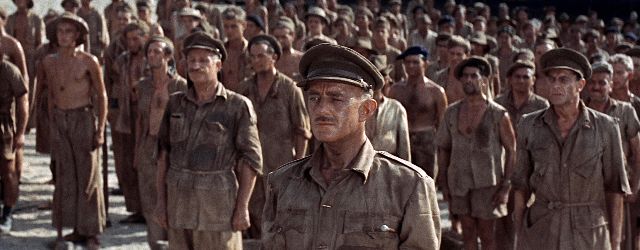The Bridge on the River Kwai (1957) 
“It spans a whole new world of entertainment!”

Director: David Lean
Cast: William Holden, Alec Guinness, Jack Hawkins
Synopsis: After settling his differences with a Japanese PoW camp commander, a British colonel co-operates to oversee his men’s construction of a railway bridge for their captors – while oblivious to a plan by the Allies to destroy it.
Watch this and other movies on Sky Cinema
The Bridge on the River Kwai was the first of director David Lean’s ‘epic’ movies. Before making it he made 12 (if you include Major Barbara, for which he received no credit) in sixteen years, after that he made just four more feature films in over 25 years. It’s not unlikely that Lean’s directing career might have taken an altogether different path had producer Sam Spiegel selected someone else for the job. It’s rumoured that John Ford, Howard Hawks and Nicholas Ray were all considered before it was given to Lean. Whether the sudden decline in Lean’s output was a good or bad thing is down to personal taste, but in this respect at least, The Bridge on the River Kwai marks a significant moment in cinematic history.
Adapted from the French-language novel by Pierre Boulle (who originally received the screenplay credit because writers Michael Wilson and Carl Foreman were both blacklisted at the time), The Bridge on the River Kwai is very loosely based on actual events, which means a totally fictional story has been built around one or two true-life incidents and characters. Alec Guinness plays British Army Lieutenant-Colonel Nicholson, a figure based on the real-life Philip Toosey, a British officer who oversaw the construction of two bridges — one steel, one wooden — over the Kwai River in Burma. Although he’s very good, it’s a little difficult to take Guinness seriously in the role simply because he comes across as the kind of prissy and officious stuffed shirt who would, behind his back, be looked upon as a figure of ridicule by the rank-and-file (but then class distinction is something that is strangely — for a British war film — overlooked here). He wears a fussy little moustache and speaks in the clipped, precise tones of an English gentleman, and yet seems to somehow command the unquestioning respect of his squaddies.
In a sly dig at the Nazi allies of the Japanese, Nicholson marches his men into the newly-constructed Camp 16 to the whistled strains of Colonel Bogey — an old marching tune to which British squaddies attached derogatory lyrics relating to the state of genitalia of the various members of the Nazi leadership — and immediately clashes with Camp Commander Major Saito (Sessue Hayakawa) over his intention to have Nicholson’s officers toil alongside his enlisted men in the construction of the eponymous bridge, work upon which is badly behind schedule. Nicholson’s refusal to permit his officers to undertake this manual labour results in the Colonel spending close to a month incarcerated in a tiny wooden hut, but he nevertheless refuses to yield, and the besieged Saito is eventually forced to capitulate.
Strangely, the adversarial relationship between Nicholson and Saito is largely forgotten once the British officer wins their battle of wills and then essentially emasculates the Japanese officer as he assumes control of the building of the bridge. While Saito is relegated to the position of bemused and curious onlooker, Nicholson grows increasingly obsessed with its completion, which he sees as an example of British superiority, and loses sight of his duty as an officer to hamper enemy operations at every opportunity. Cast in the role of hero upon emerging victorious from his initial clash with Saito, Nicholson now becomes the film’s villain, and unknowingly faces a new adversary in the form of American soldier Shears (William Holden), a former inmate of the camp who miraculously escaped, only to reluctantly return as part of a British mission led by Major Warden (Jack Hawkins) to sabotage the bridge.
There’s little of substance to Holden’s character, a half-hearted participant in a war he appears to view as the business of others. It’s almost as if he’s a symbol of America’s own attitude to the World War prior to the Japanese bombing of Pearl Harbour, while Nicholson represents Britain’s stiff-upper-lip resistance to hardship in the face of adversity, and Saito the kind of harsh regime that actively encouraged its people to sacrifice their lives for their country. As symbols go, they’re not exactly sophisticated, but their behaviour at least remains consistent, and provides a fitfully absorbing — if overlong — backdrop to an otherwise routine tale of wartime madness and heroics.
The Bridge on the River Kwai is never quite as great or important as it likes to think it is, and seems to use its spurious basis in truth and its generous budget to try and impress its audience rather than paying adequate attention to the quality of the writing, which is variable at best. The performances of Guinness and Hayakawa at least manage to overcome many of their stereotypical aspects of their characters, and the screenplay does at least succeed in peering beneath Major Saito’s sadistic mask to reveal an insight into the frightened and uncertain man beneath.
(Reviewed 7th January 2013)
httpv://www.youtube.com/watch?v=SFMmJMNRv-Q
